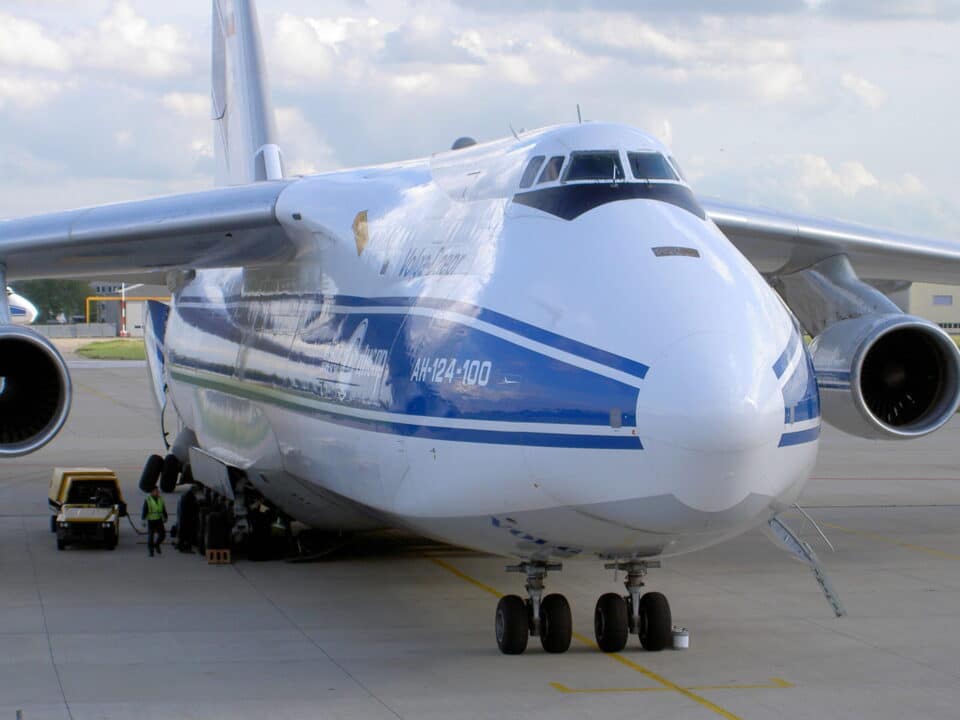Aerospace
Russian plane An-124 stuck in Canada, pays hefty parking fees $1,000 per day

Planes have an image for being costly to fly and maintain. The cost of parking a jet, on the other hand, is comparable. At Toronto Pearson Airport, the Antonov An-124, a Russian airliner, has built up daily parking fines of $1,000. According to Simple Flying, a freight plane operated by Volga-Dnepr has been based at the aforementioned airstrip since February 27, following the restriction of Canadian airspace to Russian planes.
According to simple flying Since the closing of Canadian airspace, the Volga-Dnepr An-124 has collected more than $100,000 in parking fees, according to estimates (about Rs 77.99 lakh). The plane has been sinking since Canadian Transport Minister Omar Alghabra proposed restricting Canadian airspace to Russian jets.
It is commonly known that twenty-four-hour parking at Toronto Pearson Airport costs $1,065.60 (about Rs 83,102.95). When parking fees are taken into account, you might make as much as $0.74 (about Rs 57.71) every minute. The plane has now been trapped there for more than 108 days. Furthermore, there is no evidence that Russian flights will be allowed into Canadian airspace at this time.
How did Top Gun shoot the movie in a US Navy fighter jet, and how much did it cost?
On its penultimate freight voyage, the Antonov An-124 completed COVID tests quickly. The plane arrived in Toronto on February 27th after flying from China through Anchorage and Russia, and it was scheduled to depart shortly after. Canada, on the other hand, declared that all Russian planes were forbidden from flying in its airspace during that brief period.
According to simple flying report, the plane is being stored in a’secure place,’ but no information on whether any of the collected parking fees have been paid.
World’s first ‘fly and drive car’ ready by 2021
The plane in question is a Volga-Dnepr Antonov An-124 with the registration number RA-82078. Since its introduction in 1996, it has been a component of the Russian cargo carrier fleet, and it is one of the 12 An-124s in the Volga-fleet. Dnepr’s The plane was built by Antonov, the same company that created the An-225, the world’s largest airliner.

Aerospace
Boeing Transfers Rocket Stage to NASA, Paving Way for Human Moon Mission

Boeing has achieved a significant milestone by providing NASA with the second core stage of the Space Launch System (SLS) rocket.
This crucial component, crafted at NASA’s Michoud Assembly Facility (MAF), is set to propel the Artemis II crew into lunar orbit, marking humanity’s return to deep space after a 50-year hiatus.
The monumental Boeing-built rocket stage, the largest element of the Artemis II mission, will embark on a journey aboard the Pegasus barge, traveling 900 miles to NASA’s Kennedy Space Center.
Comparison of two legendary aircraft B777x vs B747 aircraft:Click here
Upon arrival, it will be meticulously integrated with other essential Artemis II components, including the upper stage, solid rocket boosters, and NASA’s Orion spacecraft within the iconic Vehicle Assembly Building. This intricate integration process is a vital step toward the eagerly anticipated Artemis II launch, slated for 2025.
“Boeing-built products helped land humankind on the moon in 1969, and we’re proud to continue that legacy through the Artemis generation,” remarked Dave Dutcher, vice president and program manager for Boeing’s SLS program. “Together, with NASA and our industry partners and suppliers, we are building the world’s most capable rocket and paving the way to deep space through America’s rocket factory in New Orleans.”
NASA, Lockheed Martin Reveal X-59 Quiet Supersonic Aircraft:Click here
The delivery of Core Stage 2 marks a significant achievement in the evolution of the SLS rocket. Towering over 200 feet and powered by four RS-25 engines, this core stage, coupled with two solid-fueled booster rockets, will generate a staggering 8.8 million pounds of thrust. This immense power is crucial to launching Artemis II and future missions into the vast expanse of space.
The SLS rocket stands unparalleled in its capability to transport both crew and substantial cargo to the moon and beyond in a single launch. Its extraordinary capacity will facilitate the delivery of human-rated spacecraft, habitats, and scientific missions to destinations including the moon and Mars, ushering in a new era of space exploration.
-

 Travel1 week ago
Travel1 week agoAir India to Expand US Operations with Three New Routes After a Decade
-

 Travel2 weeks ago
Travel2 weeks agoWhy We Should Avoid These Stamps in a Passport
-

 Airlines1 month ago
Airlines1 month agoInvestigations Reveal Fake Chinese Titanium in Boeing and Airbus Jets
-

 Tech4 weeks ago
Tech4 weeks agoChina’s CATL Plans 1,800-Mile Electric Plane Launch by 2027
-

 Airport3 days ago
Airport3 days agoTop 10 Largest Airports in the World by Size
-

 Aerospace4 weeks ago
Aerospace4 weeks agoChina’s Fighter Jets Turn Wings into Autonomous Drones
-

 Airlines4 days ago
Airlines4 days agoAir India Rolls Out A350s for Delhi-New York JFK and Newark Routes
-

 Defence3 weeks ago
Defence3 weeks agoBoeing Enhances Chinook with New Engines and Block II Upgrades at $96 Million







